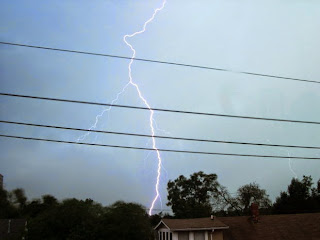How does Lightning Rods Work?
According to the science history books, the lightning rod was first invented by Benjamin Franklin way back in 1749. He was able to found out that lightning rod can actually attract lightning. And if used in the right and proper way, it can serve safety purposes. In fact, scientist had already considered lightning rods as the best protection against lightning strikes.
How does a lightning rod work?
A lightning rod consist of a long metallic pole with pointy end projecting straight upward into the sky. The suggested thickness of the rod should be around 2 cm in diameter. As for the length, most commercial products only have 10 to 12 inches long but actually, the longer-the better.
The other end of the rod must be properly connected in to a high-voltage copper or aluminum cable wires. These wires are also connected into a "Conducive Grid" (responsible for dissipating the lightning's powerful electricity) buried deep down the ground.
Since lightning rod attracts lightning, its system is well designed by engineers to withstand the highest electrical currents that a lightning can induce. Even the wires are made of specialized conducting materials that won't easily get burned.
Attracting the lightning to strike into the rod is an easy task but the real challenge is that, the electrical current induced by the lightning must follow the safety path provided by the specialized cable wires. Thus, when the rod got struck by a lightning, the electrical current travels into the cable wires down into the conducive grid.
A lightning rod should be setup at the highest top portion of the building or house. By installing it at the top most portion, this ensures that all electrical power induced by a lightning strike will be absorbed by the rod.
One common characteristic of lightning is that when it strikes a certain spot, there is a very high tendency that it will scatter around. This behavior is known as "Jump Around". The reason why a lightning's electrical discharge tends to jump around is that, it is searching for other nearby objects with the least resistances.
The lightning rod's pole is made out of highly conducive type of material. So if it happens that it has been struck by a lightning, all the electrical currents are entirely absorb preventing it from jumping around.
Today, the majority of lightning rod system design used by tall structures are the traditional "Franklin Design". It's because the fundamental principle of Franklin's design is that, it provides sufficiently "low impedance path" for the electrical discharge to travel and reach the conducive grid without causing any possible damages into the building or house. In short, the protection offered by Franklin's design is similar to the Faraday Cage.
In the early 18th century, there was a conflict between the British and American scientists. British scientists claimed that a lightning rod with a ball on its end had a better attraction to lightning strikes. But as for the American scientists, they believed that a pointed tip of the rod was a lot much better.
The controversy finally came to an end back in 2000. According to the United States latest scientific discovery, a moderately rounded or blunt-tipped lightning rod acts as the best strike receptors. Thus, most lightning rods are now designed with rounded tips.
If you are living at an area where lightning strikes often occur then you should consider installing a lightning rod system.

For houses located at an open field or flat area with less or no trees around, a very tall rod is suggested. The length of the rod must be taller than the height of the house.
Anyway, if you really do not have any idea about what you're doing then it's best to hire a professional electrician to do the lightning rod installation for you.
How does a lightning rod work?
A lightning rod consist of a long metallic pole with pointy end projecting straight upward into the sky. The suggested thickness of the rod should be around 2 cm in diameter. As for the length, most commercial products only have 10 to 12 inches long but actually, the longer-the better.
The other end of the rod must be properly connected in to a high-voltage copper or aluminum cable wires. These wires are also connected into a "Conducive Grid" (responsible for dissipating the lightning's powerful electricity) buried deep down the ground.
System of the Lightning Rod
Since lightning rod attracts lightning, its system is well designed by engineers to withstand the highest electrical currents that a lightning can induce. Even the wires are made of specialized conducting materials that won't easily get burned.
Attracting the lightning to strike into the rod is an easy task but the real challenge is that, the electrical current induced by the lightning must follow the safety path provided by the specialized cable wires. Thus, when the rod got struck by a lightning, the electrical current travels into the cable wires down into the conducive grid.
A lightning rod should be setup at the highest top portion of the building or house. By installing it at the top most portion, this ensures that all electrical power induced by a lightning strike will be absorbed by the rod.
Jump Around Characteristic of Lightning
One common characteristic of lightning is that when it strikes a certain spot, there is a very high tendency that it will scatter around. This behavior is known as "Jump Around". The reason why a lightning's electrical discharge tends to jump around is that, it is searching for other nearby objects with the least resistances.
The lightning rod's pole is made out of highly conducive type of material. So if it happens that it has been struck by a lightning, all the electrical currents are entirely absorb preventing it from jumping around.
Franklin Lightning Rod System Design
Today, the majority of lightning rod system design used by tall structures are the traditional "Franklin Design". It's because the fundamental principle of Franklin's design is that, it provides sufficiently "low impedance path" for the electrical discharge to travel and reach the conducive grid without causing any possible damages into the building or house. In short, the protection offered by Franklin's design is similar to the Faraday Cage.
The Tip of a Lightning Rod
In the early 18th century, there was a conflict between the British and American scientists. British scientists claimed that a lightning rod with a ball on its end had a better attraction to lightning strikes. But as for the American scientists, they believed that a pointed tip of the rod was a lot much better.
The controversy finally came to an end back in 2000. According to the United States latest scientific discovery, a moderately rounded or blunt-tipped lightning rod acts as the best strike receptors. Thus, most lightning rods are now designed with rounded tips.
Do you often Experience Lightning Strikes in your Area?
If you are living at an area where lightning strikes often occur then you should consider installing a lightning rod system.

For houses located at an open field or flat area with less or no trees around, a very tall rod is suggested. The length of the rod must be taller than the height of the house.
Anyway, if you really do not have any idea about what you're doing then it's best to hire a professional electrician to do the lightning rod installation for you.






